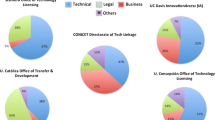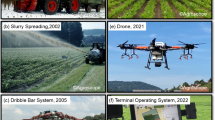Abstract
Technology transfer policies can bring public R&D to potential users, reduce burdens on public resources, and influence technology development. Patent licensing offers transparency, potentially higher research returns, and possible increased adoption of socially desirable technologies. However, it limits access to research results, and raises concerns that public institutions will alter their agendas. A review of the US Department of Agriculture's patent and licensing program addresses the types of technologies disseminated, social benefits associated with them, institutions licensing technologies, the importance of exclusivity, and whether research priorities have become oriented to private interests. Results suggest that USDA's patent licensing is not revenue driven, and its research agenda has not changed in response to the program. Licenses vary with respect to four important social benefits. Licensing program priorities are closer to those of the private sector than the USDA's research program. Partial or limited exclusivity may be sufficient to attract technology developers.
Similar content being viewed by others
References
Blalock, D.J., 2001 and 2002, Technology Licensing Program, U.S. Department of Agriculture, Agricultural Research Service, Office of Technology Transfer, Personal Communication.
Bozeman, B., 2000, ‘Technology Transfer and Public Policy: A Review of Research and Theory,’ Research Policy 29, 627–655.
Cohen, L.R. and R.G. Noll, 1996, ‘The Future of the National Laboratories,’ Proceedings of the National Academy of Sciences 93, 12678–12685.
Congressional Research Service, 1991, Transfer of Technology from Publicly Funded Research Institutions to the Private Sector. A Report Prepared by the Congressional Research Service for the Use of the Subcommittee on Oversight and Investigations of the Committee on Energy and Commerce, U.S. House of Representatives. Washington, DC: U.S. Government Printing Office.
Current Research Information System, 1985 and 1998, Inventory of Agricultural Research, Fiscal Years 1984, 1997, Washington, DC: U.S. Department of Agriculture, Cooperative State Research, Extension, and Education Service.
Economic Research Service, 2002, Economics of Foodborne DiseaseBrie ng Room, http://www.ers.usda.gov/Emphases/SafeFood/features.htm#start, Washington, DC: Economic Research Service, U.S. Department of Agriculture.
Federal Laboratory Consortium for Technology Transfer, 2002, Technology Transfer Desk Reference, Cherry Hill, NJ: Federal Laboratory Consortium for Technology Transfer, May.
Fernandez-Cornejo, J. and W.D. McBride, 2002, Adoption of Bioengineered Crops, ERS Agricultural Economic Report No. Agricultural Economics Report 810, Washington, DC: Economic Research Service, U.S. Department of Agriculture.
Fuglie, K., N. Ballenger, K. Day, C. Klotz, M. Ollinger, J. Reilly, U. Vasavada, and J. Yee, 1996, ‘Agricultural Research and Development: Public and Private Investments Under Alternative Markets and Institutions,’ Agricultural Economics Report 735, Washington, DC: Economic Research Service, U.S. Department of Agriculture.
Frisvold, G., J. Sullivan, and A. Raneses, 1999, ‘Who Gains From Genetic Improvements In U.S. Crops?’ AgBioForum 2(3:4), 237–246, retrieved February 14, 2002, from the World Wide Web: http://www.agbioforum.org.
Hayenga, M. and N. Kalaitzandonakes, 1999. ‘Structure and Coordination System Changes in the U.S. Biotech Seed and Value-added Grain Market,’ Paper presented at the International Food and Agribusiness Management Association (IAMA)World Food and Agribusiness Congress, May 1999.
Heller, M.A. and R.S. Eisenberg, 1998, ‘Can Patents Deter Innovation?The Anticommons in Biomedical Research,’ Science 280, 698–01.
Huffman, W. and R. Evenson, 1993, Science for Agriculture: A Longterm Perspective, Ames: Iowa State University Press.
Jaffe, A.B. and J. Lerner, 1995, Privatizing R&D: Patent Policy and the Commercialization of National Laboratory Technologies, Working Paper 7064, Cambridge, MA: National Bureau of Economic Research.
King, J., 2001, Concentration and Technology in Agricultural Input Industries, ERS Agriculture Information Bulletin No. 763. Washington, DC: Economic Research Service, U.S. Department of Agriculture.
Mowery, D.C., R.R. Nelson, B.N. Sampat, and A.A. Ziedos, 2001, ‘The Growth of Patenting and Licensing by US Universities: An Assessment of the Effects of the Bayh-Dole Act of 1980,’ Research Policy 30, 99–119.
National Academy of Sciences (NAS), 1972, Report of the Committee on Research Advisory to the U.S. Department of Agriculture, Washington, DC: National Academy Press.
National Research Council, 1995, Allocating Federal Funds for Science and Technology, Washington, DC: National Academy Press.
Perko, J.S. and F. Narin, 1997, ‘The Transfer of Public Science to Patented Technology: A Case Study in Agricultural Science,’ Journal of Technology Transfer 3, 65–72.
Postlewait, A., D.D. Parker, and D. Zilberman, 1993, ‘The Advent of Biotechnology and Technology Transfer in Agriculture,’ Technology Forecasting and Social Change 43, 271–287.
Rockefeller Foundation, 1982, Science for Agriculture, New York: The Rockefeller Foundation.
Schultz, T.W., 1971, ‘The Allocation of Resources to Research,’ in W.L. Fishel (ed.) Resource Allocation in Agricultural Research, Minneapolis: University of Minnesota Press.
Thursby, J.G., R. Jensen, and M.C. Thursby, 2001, ‘Incentives, Characteristics, and Outcomes of University Licensing: A Survey of Major U.S. Universities,’ Journal of Technology Transfer 26, 59–72.
Winebrake, J.J., 1992, ‘A Study of Technology-Transfer Mechanisms for Federally Funded R&D,’ Technology Transfer Fall, 54–61.
Author information
Authors and Affiliations
Rights and permissions
About this article
Cite this article
Rubenstein, K.D. Transferring Public Research: The Patent Licensing Mechanism in Agriculture. The Journal of Technology Transfer 28, 111–130 (2003). https://doi.org/10.1023/A:1022934330322
Issue Date:
DOI: https://doi.org/10.1023/A:1022934330322




